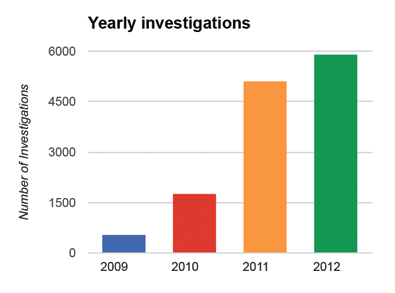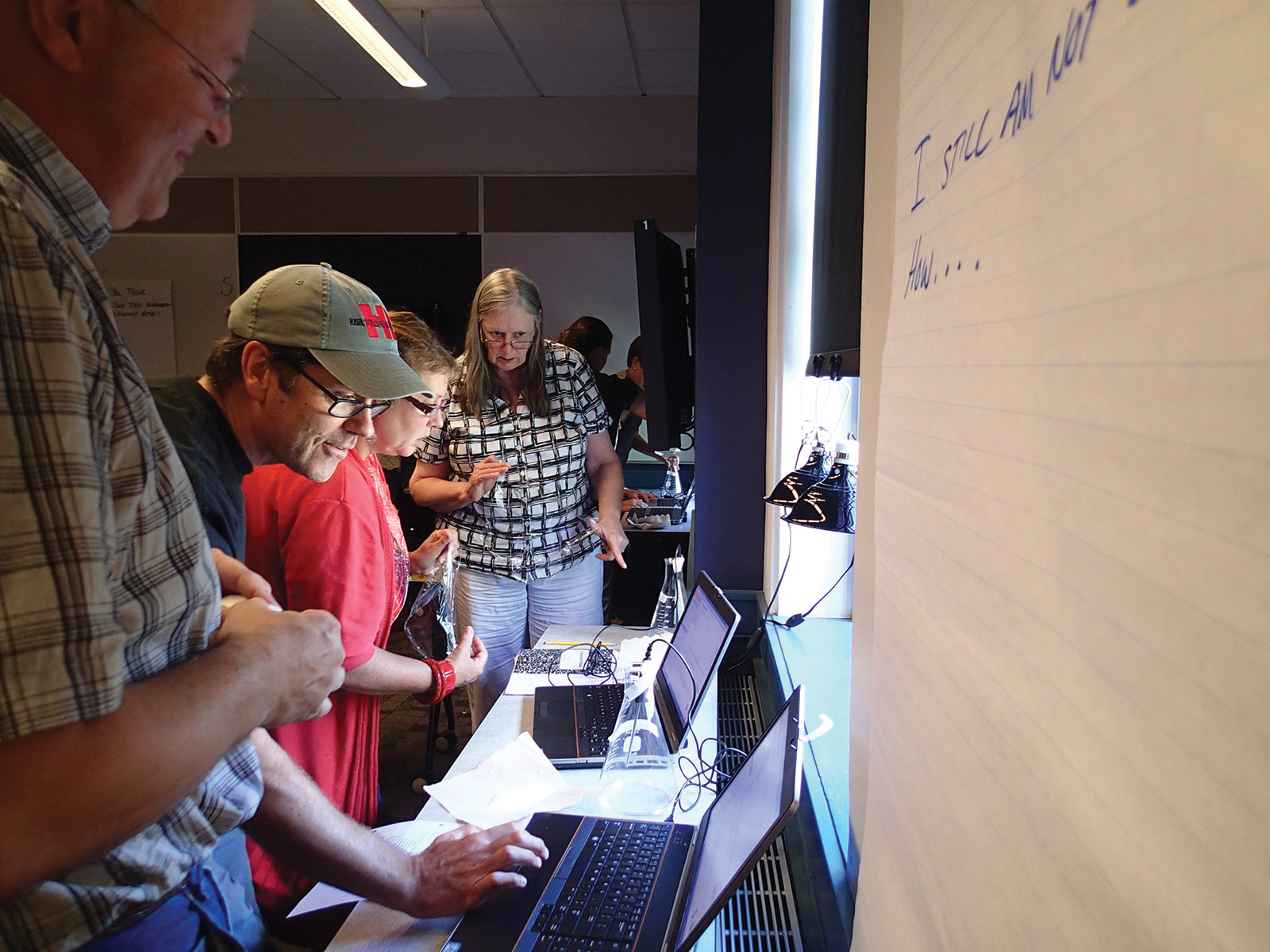Rhode Island Students Score High on Inquiry
The Rhode Island Technology Enhanced Science (RITES) project has been fomenting change in educational and institutional practices, and most importantly, in student learning across the small but diverse state of Rhode Island since 2009. Funded by the Math and Science Partnership program at the National Science Foundation, the RITES project is a unique collaboration between Rhode Island institutions of higher education, public schools, the state Department of Education and the Concord Consortium.



Through the RITES project, teachers are able to offer their middle and high school students an exciting collection of free, highly interactive online educational resources called investigations (Figure 1), created using Concord Consortium’s RITES software. The investigations are assembled, developed, customized and evaluated by teams of Rhode Island faculty, teachers and educational experts who work in pairs on discipline-specific resource teams. Students of teachers participating in the project have achieved significantly higher scores on statewide inquiry assessments than their peers taught by teachers who were not part of the project.
Each spring a new cohort of Rhode Island school districts has been recruited for a two-year period of formal participation. Over the course of the project’s five-year lifespan, most Rhode Island school districts have joined the project (Figure 2). And thanks both to new districts and veteran districts, the use of RITES curriculum materials has steadily increased (Figure 3).
Web portal
Students and teachers access investigations through a Web portal that saves and tracks student progress. A class can begin an investigation one day by reading, answering questions and collecting experimental data, and return to the investigation the next day, picking up where they left off. The portal also allows students, teachers and RITES researchers to gauge student progress. Teachers with varying access to technology in their classroom—from one computer per class to one computer per student—can successfully use the investigations by accessing either collaborative or individual student modes in the Web portal.
Opportunities for educators
RITES offers educators across the state multiple ways to get involved—from participating in summer short courses and presenting at project conferences to developing student investigations and leading professional development courses as members of resource teams.
Teachers learn how to use the investigations to foster inquiry during two elective summer courses in each of their two consecutive years of participation in RITES. Each short course focuses on a specific investigation, giving teachers time to reflect on addressing student misconceptions and enhancing student engagement and discourse. Course instructors, usually the authors of the investigation, model best practices in instructional methods. Teachers work collaboratively with colleagues from their own and other Rhode Island school districts and share strategies for reaching all learners.
At the RITES spring and fall conferences, teachers exchange ideas and showcase their students’ learning as well as their own. They receive curricular and pedagogical support through a series of breakout workshops ranging from “Engineering Practices in the Science Classroom” to “Thinking Like a Scientist.” They also lead sessions and present to one another, using student work and other classroom data to reflect on student learning and on their practice. A poster session is held at the spring conference for teachers to share their research.
RITES partnership model
NSF’s Math and Science Partnership program calls for a genuine working relationship between higher education faculty and classroom teachers. A hallmark of our approach is that within each discipline-specific resource team, we pair a higher education faculty member with a master classroom teacher to develop an investigation and a corresponding summer short course. In contrast to a top-down approach, RITES puts the expertise of classroom teachers on equal footing with the deep content knowledge of college and university faculty.
While lecture-style teaching is predominant in many college courses, master classroom teachers in middle and high school often use much more interactive and pedagogically modern approaches: fostering collaborative classrooms, supporting small group work and utilizing a variety of scaffolding techniques such as eliciting student thinking prior to addressing a topic, as well as “jigsaw” and other exchanges between small groups of students. Bringing deep content knowledge together with deep pedagogy means that both members of a pair have expertise to share.
An overarching goal of the expertise pairing is to build sustainability, so the program’s effects continue post-funding. RITES funding has established permanent tenure-track faculty positions at the University of Rhode Island and Rhode Island College that bring together education, science and technology with the mission to foster a two-way connection between higher education and classroom teaching.
Positive effects on educators and education
A team of RITES collaborators researched the effects of resource team participation by surveying the individual team members on their experience with RITES materials and course development. Ninety percent of classroom teachers and 80 percent of higher education faculty responded that working with a resource partner was an enriching and valuable experience. Faculty and classroom teachers both responded that they would like to engage in similar professional development efforts in the future, and the vast majority of college and university faculty indicated that the approaches to learning in the investigations and summer courses could be adapted for use in their courses. Teachers reported that they were increasingly using technology in their classrooms and many were now seen as a science education resource in their schools. Many participants reported that one year later they still had regular communication with their partner.
Positive effects on students
In 2012, RITES researchers compared the performance of students of RITES and non-RITES teachers on the New England Common Assessment Program’s (NECAP) standardized tests, which are given in 8th and 11th grades. The researchers targeted three RITES districts for which data were available at the time. Since the content questions on the test change each year and are not valid for comparison purposes, the researchers focused on the science inquiry portion of the test. The results indicate that students of RITES-trained teachers scored higher on the science inquiry tasks than students of teachers who did not receive RITES training (Table 1). Significant differences for the RITES program were found in an urban school district (Providence) serving predominantly African American and Hispanic students, as well as in urban ring communities (Cranston and Johnston). The results were statistically significant even after controlling for the effects of poverty, minority group membership, special education and Limited English proficiency status.
As more schools are able to harness their demographic and NECAP data, RITES researchers will continue to study additional Rhode Island districts.
Table 1. The summer short courses were first taught in the summer of 2009. The data shown for 2010 are from the NECAP tests administered in the following academic year. The results showed no significant differences between students of RITES and non-RITES teachers. In 2011, following the second summer of the two-year training, students of RITES-trained teachers obtained significantly higher scores, suggesting either that the changes to teacher practice were manifest only after the full training, or that the evolving RITES professional development model was maturing, or both. In 2012, following the first summer of participation for Providence and Cranston, student achievement was significantly higher for students of RITES teachers. These data reinforce the idea that the RITES professional development model was evolving to support greater teacher improvement following the first year of teacher participation.
| Grade 8 Results — NECAP Inquiry Subscore Improvement RITES vs Non-RITES | ||||||||||||
|---|---|---|---|---|---|---|---|---|---|---|---|---|
| 2010 | 2011 | 2012 | ||||||||||
| District | Total | RITES | ? | p | Total | RITES | ? | p | Total | RITES | ? | p |
| Johnston | 295 | 101 | -4% | n.s. | 238 | 182 | 20% | <0.01 | ||||
| Cranston | 808 | 46 | 29% | <0.001 | ||||||||
| Providence | 1755 | 1387 | 106% | <0.001 | ||||||||
| Grade 11 Results — NECAP Inquiry Subscore Improvement RITES vs Non-RITES | ||||||||||||
|---|---|---|---|---|---|---|---|---|---|---|---|---|
| 2010 | 2011 | 2012 | ||||||||||
| District | Total | RITES | ? | p | Total | RITES | ? | p | Total | RITES | ? | p |
| Cranston | 813 | 149 | -1% | n.s. | 853 | 191 | 20% | <0.001 | ||||
| Providence | 1435 | 1053 | 10% | <0.05 | ||||||||
Total = Total number of students tested
RITES = Number of RITES students
? = Percent improvement between RITES and non-RITES students
p = Significance of the p-value (n.s. is not significant)
Frieda Reichsman (freichsman@concord.org) directs the RITES project at the Concord Consortium.
William Day (wday@ritesproject.net) is the Technology Liaison for the RITES project.

